|
Figure 1 is based on a
photograph of a Marine of the III. Seebataillon on Police Duty taken
in China shortly after the Boxer Rebellion. He wears the dark blue M1893
Litewka tunic which was worn by the Seebataillone on overseas active
winter service at the time of the Boxer Rebellion. It had concealed front
buttons, no exterior pockets and gathered cuffs with one small horn
button. On the Litewka the Seebataillone wore the same white shoulder
straps with yellow Imperial crown, crossed anchors and battalion numeral
as on the home and tropical uniform (see right). The Litewka
collar featured a white collar patch with the Seebataillon yellow
double Litzen.
This marine wears a Chinese Police brassard
(see below right). The III. Seebataillon provided officers for the Chinese
police force but also formed a small German police force in Tsingtao to
act as Military Police for the garrison and the German population.
Curiously this Seesoldat is wearing the on-board cap usually
reserved for wearing on ships. It was a white peakless naval style cap
with a light blue hatband and a small imperial cockade. One other
photograph of the German Police in Tsingtao also shows them wearing the
on board cap, so it is possible that it was worn on police duties. Most members of
the Seebataillone during the Boxer Rebellion and afterwards wore the blue
field cap with white hatband as seen in the next figure.
The trousers are
those to match the M1895 blue tunic with white piping, boots and M1895
equipment are of brown leather. The belt buckle worn by the Seebataillone
was the same two metal, Imperial version as worn by the Navy and the
Schutztruppe. His bayonet knot can be seen hanging by his left side. The
Seebataillone wore bayonet knots which distinguished the soldiers'
battalion and company in the same manner as the German army of the time.
Figure 2 is based on a
photograph of a Marine of the III. Seebataillon taken in China
either during or shortly after the Boxer Rebellion. He also wears the
dark blue M1893 Litewka tunic as described above (see right). This Seesoldat is
typical of members of the III. Seebataillon of this period in that he
wears the blue
peakless field cap with white hatband and small Imperial cockade. Again,
the trousers are
those to match the M1895 blue tunic with white piping, boots and M1895
equipment are of brown leather. He wears his M1867 dark grey/black
greatcoat rolled over his shoulder as was not uncommon in the field.
|
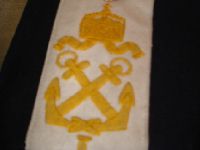
Details of the Shoulder Strap
(See
Seebataillon
Blue Uniform Details Page)
Photo Copyright Doppler
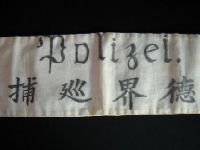
Tsingtao Police Armband
(See
Identification Brassards Details Page)
Photo Copyright Doppler
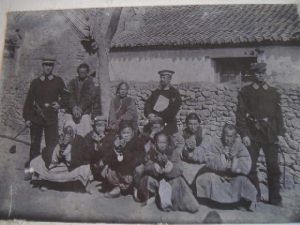
Seebataillon troops with M1893
Litewka
(see
Full Version of this Photograph)
Photo Copyright Doppler |
|
Figure 4 is based on a
photograph of an Officer of the Marine Expeditionskorps, Major von
Glasenapp, taken in German South West Africa during the Herero
Rebellion. While in inclement weather other ranks wore the blue Litewka
as seen on the previous figure, Officers of the Marine Expeditionskorps
to South West Africa wore the Schutztruppe grey-brown corduroy Litewka.
Some sources say it was worn with a blue cloth collar and white
Schutztruppe Litzen, while photographs show that at least some of those
issued to the Seebataillone had plain
corduroy collars in the usual Schutztruppe manner (see below right). Officers were also issued Schutztruppe Südwester
hats although this officer wears his Seebataillon dark blue peaked
cap with white hatband and piping and a small imperial cockade on the
front (see right). Major von Glasenapp's rank is shown by the usual
means on the shoulder straps (see
Officers Rank Insignia Page). Franz Georg von
Glasenapp (1857-1914) was first
commissioned into the 9th Infantry Regiment in 1874. His first
overseas post was training and reorganising the Chinese army for three
years starting in 1885. He later served in the
Boxer Rebellion against the Chinese and went on to command the II.
Seebataillon in 1902,
then the I. Seebataillon in 1905. During the Herero War he commanded
the Marine Expeditionskorps in South West Africa where he was wounded
in action. From 1911 until his death in August 1914 he was the overall
commander of the Schutztruppe based at the Colonial Office in Berlin
with the rank of Major General.
|
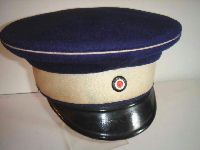
Seebataillon Peaked Cap
(See
Field Cap Details Page)
Photo Copyright Doppler
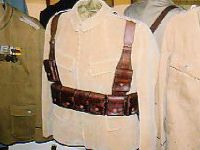
Schutztruppe Kord Litewka
(See Swakopmund Museum Photos Page)
Photo Copyright Phil Buhler |
|
Figure 5 is based on a
photograph of a Marine of the III. Seebataillon taken in China shortly
before the First World War. By 1914 the M1900 grey Litewka (see right) had
replaced the old blue Litewka for winter service dress overseas. It varied
from the M1893 pattern not only in colour but also in having plain cuffs
and two buttoned hip pockets. It had the same white collar patches with
yellow double Litzen and shoulder straps (although this Seesoldat has
removed his shoulder straps as was common in action, just leaving the button and retaining
band at either end) and the same concealed front (although some
photographs show individual Seesoldaten in Tsingtao wearing the grey
Litewka with five buttons down the front). He wears the peakless field cap in blue with white
hatband and piping and a small imperial cockade at the front. A similar
peaked version was worn by NCOs and officers (see right). The
trousers are blue with white piping as worn with the M1895
blue tunic. The brown leather boots were usually worn over the trousers.
Equipment is still the old M1895 pattern in brown leather.
Judging from photographs of recently captured
POWs at Tsingtao this was the uniform worn by the III. Seebataillon in action
during the latter stages of the battle for Tsingtao in 1914 (also see
below right). The German Navy, including the Seebataillone, officially wore Winter uniforms from
September 20th to April 20th. Photographs of POWs from the East Asian Marine Detachment
taken shortly after the Siege of Tsingtao show them wearing the same
grey Litewkas with blue peakless caps and trousers. |
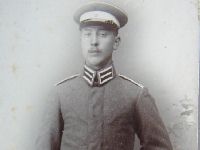
Seebataillon NCO in M1900 Litewka
(see Full Version of this Photograph)
Photo Copyright Doppler
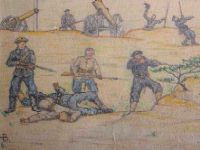
Eyewitness sketch of the last
defenders at Tsingtao
(See
Pictures from China Page)
Photo Copyright Doppler |